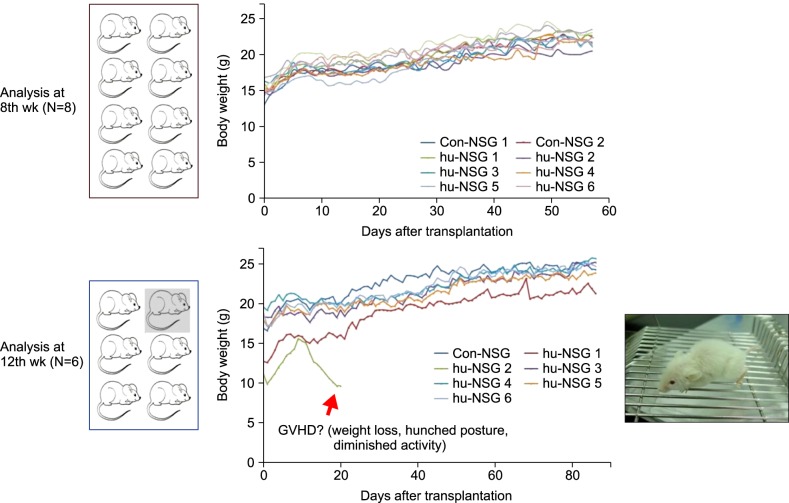1. McClure HM. Nonhuman primate models for human disease. Adv Vet Sci Comp Med. 1984; 28:267–304. PMID:
6395673.

2. Hu SL. Non-human primate models for AIDS vaccine research. Curr Drug Targets Infect Disord. 2005; 5:193–201. PMID:
15975024.

3. Shultz LD, Brehm MA, Garcia-Martinez JV, Greiner DL. Humanized mice for immune system investigation: progress, promise and challenges. Nat Rev Immunol. 2012; 12:786–798. PMID:
23059428.

4. Brehm MA, Jouvet N, Greiner DL, Shultz LD. Humanized mice for the study of infectious diseases. Curr Opin Immunol. 2013; 25:428–435. PMID:
23751490.

5. King M, Pearson T, Shultz LD, et al. A new Hu-PBL model for the study of human islet alloreactivity based on NOD-scid mice bearing a targeted mutation in the IL-2 receptor gamma chain gene. Clin Immunol. 2008; 126:303–314. PMID:
18096436.

6. Harui A, Kiertscher SM, Roth MD. Reconstitution of huPBL-NSG mice with donor-matched dendritic cells enables antigen-specific T-cell activation. J Neuroimmune Pharmacol. 2011; 6:148–157. PMID:
20532647.

7. Sugimoto K, Adachi Y, Moriyama K, et al. Induction of the expression of SCF in mouse by lethal irradiation. Growth Factors. 2001; 19:219–231. PMID:
11811778.

8. Hayakawa J, Hsieh MM, Uchida N, Phang O, Tisdale JF. Busulfan produces efficient human cell engraftment in NOD/LtSz-Scid IL2Rgamma(null) mice. Stem Cells. 2009; 27:175–182. PMID:
18927475.
9. Robert-Richard E, Ged C, Ortet J, et al. Human cell engraftment after busulfan or irradiation conditioning of NOD/SCID mice. Haematologica. 2006; 91:1384. PMID:
17018389.
10. Choi B, Chun E, Kim M, et al. Human B cell development and antibody production in humanized NOD/SCID/IL-2Rγ(null) (NSG) mice conditioned by busulfan. J Clin Immunol. 2011; 31:253–264. PMID:
20981478.

11. Kim M, Choi B, Kim SY, et al. Co-transplantation of fetal bone tissue facilitates the development and reconstitution in human B cells in humanized NOD/SCID/IL-2Rγnull (NSG) mice. J Clin Immunol. 2011; 31:699–709. PMID:
21544592.

12. Chevaleyre J, Duchez P, Rodriguez L, et al. Busulfan administration flexibility increases the applicability of scid repopulating cell assay in NSG mouse model. PLoS One. 2013; 8:e74361. PMID:
24069300.

13. Yardeni T, Eckhaus M, Morris HD, Huizing M, Hoogstraten-Miller S. Retro-orbital injections in mice. Lab Anim (NY). 2011; 40:155–160. PMID:
21508954.

14. Suckow MA, Danneman P, Brayton C, editors. The laboratory mouse. Boca Raton, FL: CRC Press;2001.
15. Price JE, Barth RF, Johnson CW, Staubus AE. Injection of cells and monoclonal antibodies into mice: comparison of tail vein and retroorbital routes. Proc Soc Exp Biol Med. 1984; 177:347–353. PMID:
6091149.

16. Steel CD, Stephens AL, Hahto SM, Singletary SJ, Ciavarra RP. Comparison of the lateral tail vein and the retro-orbital venous sinus as routes of intravenous drug delivery in a transgenic mouse model. Lab Anim (NY). 2008; 37:26–32. PMID:
18094699.

17. Singh M, Singh P, Gaudray G, et al. An improved protocol for efficient engraftment in NOD/LTSZ-SCIDIL-2Rγnull mice allows HIV replication and development of anti-HIV immune responses. PLoS One. 2012; 7:e38491. PMID:
22675567.

18. Lee M, Jeong SY, Ha J, et al. Low immunogenicity of allogeneic human umbilical cord blood-derived mesenchymal stem cells in vitro and in vivo. Biochem Biophys Res Commun. 2014; 446:983–989. PMID:
24657442.

19. Ishikawa F. Modeling normal and malignant human hematopoiesis in vivo through newborn NSG xenotransplantation. Int J Hematol. 2013; 98:634–640. PMID:
24258713.

20. Ciurea SO, Andersson BS. Busulfan in hematopoietic stem cell transplantation. Biol Blood Marrow Transplant. 2009; 15:523–536. PMID:
19361744.

21. Li Y, Chen Q, Zheng D, et al. Induction of functional human macrophages from bone marrow promonocytes by M-CSF in humanized mice. J Immunol. 2013; 191:3192–3199. PMID:
23935193.

22. O'Connell RM, Balazs AB, Rao DS, Kivork C, Yang L, Baltimore D. Lentiviral vector delivery of human interleukin-7 (hIL-7) to human immune system (HIS) mice expands T lymphocyte populations. PLoS One. 2010; 5:e12009. PMID:
20700454.
23. Brehm MA, Shultz LD, Luban J, Greiner DL. Overcoming current limitations in humanized mouse research. J Infect Dis. 2013; 208(Suppl 2):S125–S130. PMID:
24151318.

24. Drake AC, Chen Q, Chen J. Engineering humanized mice for improved hematopoietic reconstitution. Cell Mol Immunol. 2012; 9:215–224. PMID:
22425741.

25. Covassin L, Jangalwe S, Jouvet N, et al. Human immune system development and survival of non-obese diabetic (NOD)-scid IL2rγ(null) (NSG) mice engrafted with human thymus and autologous haematopoietic stem cells. Clin Exp Immunol. 2013; 174:372–388. PMID:
23869841.

26. Lavender KJ, Messer RJ, Race B, Hasenkrug KJ. Production of bone marrow, liver, thymus (BLT) humanized mice on the C57BL/6 Rag2(-/-)γc(-/-)CD47(-/-) background. J Immunol Methods. 2014; 407:127–134. PMID:
24769067.

27. Choi B, Chun E, Kim M, et al. Human T cell development in the liver of humanized NOD/SCID/IL-2Rγ(null)(NSG) mice generated by intrahepatic injection of CD34(+) human (h) cord blood (CB) cells. Clin Immunol. 2011; 139:321–335. PMID:
21429805.

28. van Lent AU, Dontje W, Nagasawa M, et al. IL-7 enhances thymichuman T cell development in "human immune system" Rag2-/- IL-2Rgammac-/- mice without affecting peripheral T cell homeostasis. J Immunol. 2009; 183:7645–7655. PMID:
19923447.
29. Chen Q, Khoury M, Chen J. Expression of human cytokines dramatically improves reconstitution of specific human-blood lineage cells in humanized mice. Proc Natl Acad Sci U S A. 2009; 106:21783–21788. PMID:
19966223.








 PDF
PDF ePub
ePub Citation
Citation Print
Print




 XML Download
XML Download